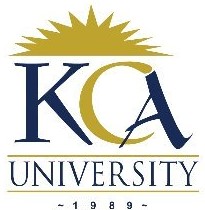 UNIVERSITY EXAMINATIONS: 2012/2013
UNIVERSITY EXAMINATIONS: 2012/2013
EXAMINATION FOR THE BACHELOR OF SCIENCE IN
INFORMATION TECHNOLOGY
BIT 4304 DISTRIBUTED INTELLIGENT SYSTEMS
DATE: AUGUST, 2013 TIME: 2 HOURS
INSTRUCTIONS: Answer Question ONE and Any Other TWO Questions
QUESTION ONE
a) Briefly explain the meaning of the following terms in the context of distributed
intelligent agents
i). sphere of influence (2 Marks)
iii) WOD (2 Marks)
b) Identify and explain five properties that you would associate with the concept of
an intelligent agent.‟ (5 Marks)
c) Agents are related to but distinct from “objects” in the sense of object-oriented
programming. Explain four distinctions between the two concepts. (4 Marks)
d) Briefly explain the term “speech act” .Give two examples to illustrate your
answer. (4 Marks)
e) Describe the structure of messages in either the KQML or FIPA agent
communication languages. Give one example for each case. (4 Marks)
f) Describe three functions of KIF agent communication language: (3 Marks)
g) Describe the meaning of the term „sensors‟ (2 Marks)
h) Explain how multi agents systems can be applied in ecommerce (4 Marks)
QUESTION TWO
a) Describe the role of the INFORMATIVE and NEGOTIATION categories of
performatives in the FIPA agent communication language. Give one example for
each category. (4 Marks)
b) The CONTRACT NET protocol is perhaps the most widely used cooperation
protocol in the multi-agent systems world. Briefly describe the protocol and the
main stages of I.T. (10 Marks)
c) Explain three benefits of using contract mechanism in distributed intelligent
agents. (3 Marks)
d) State and explain three types of agent environments (3 Marks)
QUESTION THREE
a) Describe the term „black board systems‟ as used in distributed intelligent agents
explain any three characteristics are associated with it. (5 Marks)
b) Distinguish between symbolic and reactive agent architectures. (2 Marks)
c) Distinguish between intentions and desires in the context of agent architectures.
(2 Marks)
d) Many buses in mombasa have drivers and conductors. The two work together.
Lets assume that both are intelligent agents. Fill-in the table below for the
conductor. (4 Marks)
e) Describe four properties of a multi-agent system (5 marks)
f) Briefly explain two participants in an auction (2 marks)
Goals
environment
Percepts
Sensors
Actions
effectors
QUESTION FOUR
a) Explain the following terms
i) Seller Reservation price (2 Marks)
ii) Negotiation (2 Marks)
iii) Bidder (2 Marks)
b) What is meant by the term „proative Agents‟? Explain with an example. (3 Marks)
c) Arguments can be attacked on three main sections. State and explain each of these
sections. (3 Marks)
d) Briefly explain two methods of attacking an argument in the context of agent
argumentation. Give one example for each case. ( 4 Marks)
e) Briefly explain the meaning of the term „pareto improvement‟ in agent
interactions. Give one example to illustrate your answer (4 Marks)
QUESTION FIVE
a) Describe the meaning of the following terms:
i) means-end reasoning (2 Marks)
iii) social welfare (2 Marks)
b) Consider a game of two players Tom and Sam. In this game there are several
choices players can make.
if both choose option A, each will both receive $1
ii if both choose option B , each will receive zero reward
If one of the player chooses A, he will receive $1 and the one who chooses B gets
-$1
i) Construct a payoff matrix to represent the scenario. (2 Marks)
ii) Use the matrix to Identify the following concepts. Justify your answer in
each case
iii) Nash equilibrium strategies (2 Marks)
iv) The out come that maximizes social welfare (2 Marks)
v) Dominant strategy (2Marks)
c) “Real‟ intelligence is situated in the world, not in disembodied systems such as
Theorem provers or expert systems”. Explain this statement. (2 Marks)
d) Outline the Typical auction algorithm as used in distributed intelligent agents
( 6 marks)
